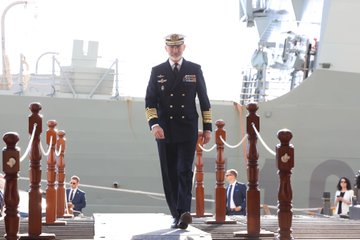
After celebrating the 10th anniversary of his proclamation last week with two days of events and engagements, it was back to business for King Felipe.
On Sunday, 23rd June, His Majesty departed for official visits to the three Baltic Republics of Estonia, Lithuania and Latvia, to “reinforce bilateral relations and visit military operation areas in the three countries”.
The first stop was Tallinn, where King Felipe drove directly to Kadriog Palace, where he received the official welcome by President Alar Karis.
After the traditional part of the ceremony, the two Heads of State held a bilateral meeting with their respective delegations, during which they touched upon the two countries’ bilateral relations, as well as strategies to commonly tackle the security situation in the region.
After a visit to the Estonian Parliament, King Felipe changed into his Navy uniform to visit the Juan Carlos I ship and the Blas de Lezo frigate, which are taking part in NATO exercises. The King of Spain was also shown other vessels taking part in the coordinated manoeuvres in the Baltic.
King Felipe and President Karis then went back to the Presidential Palace, where they received a tour of an exhibition titled “Black and White Spain. Vision of Spain, from Fortuny to Picasso”, realised with contributions from 15 Spanish Museums and private collections.
The day ended with the traditional official dinner, also held at Kadriog Palace, during which both heads of state gave short speeches. In particular, King Felipe, speaking in English, said in part: “It is precisely at these moments that we can count on our true friends. Those with whom we share common values and principles, and a close or similar vision of the world”.
The next day, it was on to Lithuania. King Felipe landed at Vilnius International Airport, where he was welcomed by the Spanish Ambassador to Lithuania, the Chancellor of the Office of the Lithuanian President, and the Lithuanian Ambassador to Spain.
From the airport, he was driven to the Presidential Palace, where he received the official welcome from President Nauseda. Afterwards, the two Heads of State held a meeting, before sitting down for a working lunch, during which they both gave a speech. King Felipe once again spoke English, and said in part: “As partners and allies in the EU and NATO, we share a common vision for a free and united Europe”.
After the homage to the fallen at Antakalnis Cemetery, His Majesty visited the Parliament, where he met its President, signed the Guest Book and was shown the monument that commemorates the fallen of the 13th of January 1991 in the fight against USSR forces who were opposing the independence of the country.
King Felipe then changed into his Air Force uniform and reunited with President Nauseda to visit the Šiauliai Aerial Base, where the Vilkas Tactical Aerial Division is based. The two heads of state observed as a training exercised was carried out simulating an intrusion alert for Lithuanian airspace, with the subsequent orders to intercept and verify.
The Vilkas Tactical Aerial Division has been functioning as the de facto Aerial Police for NATO airspace, which is why its training and cooperation with NATO forces have been boosted over the past two years.
The last stop of the trip was Riga, in Latvia, where King Felipe landed, still in his Air Force uniform, in the evening of the 24th of June. The following day began with the official welcome ceremony, which was held at the Riga Castle.
Afterwards, the King of Spain and President Rinkēvičs held a closed-door meeting, before moving to the Freedom Monument, where they paid homage to those who lost their lives during the Latvian War of Independence.
His next meeting was with Prime Minister Silina, during which the two are said to have discussed bilateral ties, as well as common challenges in the management of the area’s security situation.
His Majesty then visited Parliament, before receiving a tour of the Latvian Museum of Occupation, which celebrates the county’s history between 1940 and 1991.
It was then time for the last official lunch, and the last speech, which, once again, the King gave in English, saying in part: “Although at the opposite sides of the European continent, we share a set of values and principles that transcend geographical boundaries. In this sense, I would like to emphasise Spain’s solidarity and firm support of Ukraine”.
In the afternoon, King Felipe wore his Army uniform and, accompanied by President Rinkēvičs and the Spanish and Latvian Ministers of Defence, visited the Adazi military base, where a Spanish Army contingent is deployed.
After a presentation of the unit stationed there, His Majesty posed for a picture with the Spanish soldiers, before visiting the motor pool vehicles used by the men on the base, as well as the Aerial Defence Unit.
The trip was concluded by a meeting with the Spanish soldiers deployed to Latvia.
This trip comes as the three baltic Nations face increasing pressure on their defences, due to the Russian invasion of Ukraine, and the subsequent fears of a conflict that would expand to NATO territory.
For this reason, NATO has been holding an increased number of exercises in border territories, with the latest being currently underway in the Baltic sea, as well as the territories and aerial spaces of Estonia, Lithuania and Latvia.
As a proud member of NATO, Spain has contributed both personnel and equipment to these exercises, as well as providing humanitarian aid to Ukrainian displaced people and refugees through their cooperation agencies, including the Spanish branch of the Red Cross.

